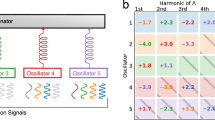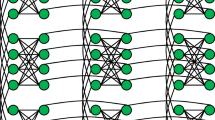Abstract
Due to the physical limit in connectivity between qubits in Quantum Annealing Processors (QAPs), when sampling from a problem formulated as an Ising graph model, it is necessary to embed the problem onto the physical lattice of qubits. A valid mapping of the problem nodes into qubits often requires qubit chains to ensure connectivity.
We introduce the concept of layout-awareness for embedding; wherein information about the layout of the input and target graphs is used to guide the allocation of qubits to each problem node. We then evaluate the consequent impact on the sampling distribution obtained from D-Wave’s QAP, and provide a set of tools to assist developers in targeting QAP architectures using layout-awareness. We quantify the results from a layout-agnostic and a layout-aware embedding algorithm on (a) the success rate and time at finding valid embeddings, (b) the metrics of the resulting chains and interactions, and (c) the energy profile of the annealing samples. The latter results are obtained by running experiments on a D-Wave Quantum Annealer, and are directly related to the ability of the device to solve complex problems.
Our technique effectively reduces the search space, which improves the time and success rate of the embedding algorithm and/or finds mappings that result in lower energy samples from the QAP. Together, these contributions are an important step towards an understanding of how near-future Computer-Aided Design (CAD) tools can work in concert with quantum computing technologies to solve previously intractable problems.
Access this chapter
Tax calculation will be finalised at checkout
Purchases are for personal use only
Similar content being viewed by others
Notes
- 1.
With
 ;
;  ;
;  ; \(\hat{\sigma }_\alpha ^{(i)}= \overbrace{I\otimes ... \otimes I}^{i-1} \otimes \hat{\sigma }_\alpha \overbrace{\otimes I\otimes ... \otimes I}^{N-i}\).
; \(\hat{\sigma }_\alpha ^{(i)}= \overbrace{I\otimes ... \otimes I}^{i-1} \otimes \hat{\sigma }_\alpha \overbrace{\otimes I\otimes ... \otimes I}^{N-i}\). - 2.
We also developed a flow for future QAP architectures, such as Pegasus [8], but Pegasus machines have not been made available for public usage.
References
Adachi, S.H., Henderson, M.P.: Application of quantum annealing to training of deep neural networks, p. 18, October 2015. arXiv preprint: arXiv:1510.06356
Amin, M.H., Andriyash, E., Rolfe, J., et al.: Quantum Boltzmann machine. Phys. Rev. X 8(2) (2018). https://doi.org/10.1103/PhysRevX.8.021050
Asghar, A., Parvez, H.: An improved diffusion based placement algorithm for reducing interconnect demand in congested regions of FPGAs. Int. J. Reconfigurable Comput. 2015, 1–10 (2015). http://www.hindawi.com/journals/ijrc/2015/756014/
Benedetti, M., Realpe-Gómez, J., Perdomo-Ortiz, A.: Quantum-assisted Helmholtz machines: a quantum-classical deep learning framework for industrial datasets in near-term devices. Quantum Sci. Technol. 3(3), 34007 (2018). https://doi.org/10.1088/2058-9565/aabd98
Bian, Z., Chudak, F., Israel, R., et al.: Discrete optimization using quantum annealing on sparse Ising models. Front. Phys. 2, 56 (2014). http://journal.frontiersin.org/article/10.3389/fphy.2014.00056
Bian, Z., Chudak, F., Israel, R., et al.: Mapping constrained optimization problems to quantum annealing with application to fault diagnosis. Front. ICT 3, 14 (2016). http://journal.frontiersin.org/article/10.3389/fict.2016.00014
Bian, Z., Chudak, F., Macready, W.G., et al.: Experimental determination of Ramsey numbers. Phys. Rev. Lett. 111(13) (2013). https://doi.org/10.1103/PhysRevLett.111.130505
Boothby, K., Bunyk, P., Raymond, J., Roy, A.: Next-generation topology of D-wave quantum processors. Technical report (2019). https://www.dwavesys.com/sites/default/files/14-1026A-C_Next-Generation-Topology-of-DW-Quantum-Processors.pdf
Boothby, T., King, A.D., Roy, A.: Fast clique minor generation in Chimera qubit connectivity graphs. Quantum Inf. Process. 15(1), 495–508 (2016). https://doi.org/10.1007/s11128-015-1150-6
Bunyk, P.I., Hoskinson, E.M., Johnson, M.W., et al.: Architectural considerations in the design of a superconducting quantum annealing processor. IEEE Trans. Appl. Supercond. 24(4), 1–10 (2014). https://arxiv.org/abs/1401.5504
Cai, J., Macready, W.G., Roy, A.: A practical heuristic for finding graph minors. Quantum (2014). http://arxiv.org/abs/1406.2741
Choi, V.: Minor-embedding in adiabatic quantum computation: I. The parameter setting problem. Quantum Inf. Process. 7(5), 193–209 (2008). https://doi.org/10.1007/s11128-008-0082-9
Choi, V.: Minor-embedding in adiabatic quantum computation: II. Minor-universal graph design. Quantum Inf. Process. 10(3), 343–353 (2011). https://doi.org/10.1007/s11128-010-0200-3
D-Wave Systems Inc.: D-Wave Leap (2018). https://cloud.dwavesys.com/leap/
D-Wave Systems Inc.: Source Repository for MinorMiner. Version 0.1.7 (2019). https://github.com/dwavesystems/minorminer
Djidjev, H.N., Chapuis, G., Hahn, G., Rizk, G.: Efficient combinatorial optimization using quantum annealing, January 2018. https://arxiv.org/abs/1801.08653
Dorband, J.E.: Stochastic characteristics of Qubits and Qubit chains on the D-Wave 2X, June 2016. http://arxiv.org/abs/1606.05550
Douglass, A., King, A.D., Raymond, J.: Constructing SAT filters with a quantum annealer. In: Heule, M., Weaver, S. (eds.) SAT 2015. LNCS, vol. 9340, pp. 104–120. Springer, Cham (2015). https://doi.org/10.1007/978-3-319-24318-4_9
Harris, R., Johnson, M.W., Lanting, T., et al.: Experimental investigation of an eight-qubit unit cell in a superconducting optimization processor. Phys. Rev. B Condens. Matter Mater. Phys. 82(2), 24511 (2010). https://doi.org/10.1103/PhysRevB.82.024511
Harris, R., Sato, Y., Berkley, A.J., et al.: Phase transitions in a programmable quantum spin glass simulator. Science (New York) 361(6398), 162–165 (2018). http://www.ncbi.nlm.nih.gov/pubmed/30002250
Huff, T., Labidi, H., Rashidi, M., et al.: Binary atomic silicon logic. Nat. Electron. 1(12), 636–643 (2018). http://arxiv.org/abs/1706.07427, http://www.nature.com/articles/s41928-018-0180-3
Jiang, S., Britt, K.A., McCaskey, A.J., et al.: Quantum annealing for prime factorization, April 2018. http://arxiv.org/abs/1804.02733
Johnson, M.J.: Future hardware directions of quantum annealing (2018). https://www.dwavesys.com/sites/default/files/mwj_dwave_qubits2018.pdf
Könz, M.S., Mazzola, G., Ochoa, A.J., et al.: Uncertain fate of fair sampling in quantum annealing, June 2018. http://arxiv.org/abs/1806.06081
Korenkevych, D., Xue, Y., Bian, Z., et al.: Benchmarking quantum hardware for training of fully visible Boltzmann machines, November 2016. http://arxiv.org/abs/1611.04528
Li, R.Y., Di Felice, R., Rohs, R., Lidar, D.A.: Quantum annealing versus classical machine learning applied to a simplified computational biology problem. NPJ Quantum Inf. 4(1), 14 (2018). http://www.nature.com/articles/s41534-018-0060-8
Lucas, A.: Ising formulations of many NP problems. Front. Phys. 2, 5 (2014). https://www.frontiersin.org/article/10.3389/fphy.2014.00005
Mandrà, S., Zhu, Z., Katzgraber, H.G.: Exponentially biased ground-state sampling of quantum annealing machines with transverse-field driving Hamiltonians. Phys. Rev. Lett. 118(7), 070502 (2017). https://doi.org/10.1103/PhysRevLett.118.070502
McMurchie, L., Ebeling, C.: PathFinder: a negotiation-based performance-driven router for FPGAs. In: Proceedings of the 1995 ACM Third International Symposium on Field-programmable Gate Arrays, FPGA 1995, pp. 111–117. ACM, New York (1995). http://doi.acm.org/10.1145/201310.201328
Mishra, A., Albash, T., Lidar, D.A.: Finite temperature quantum annealing solving exponentially small gap problem with non-monotonic success probability. Nat. Commun. 9(1), 2917 (2018). http://www.nature.com/articles/s41467-018-05239-9
Mott, A., Job, J., Vlimant, J.R., et al.: Solving a Higgs optimization problem with quantum annealing for machine learning. Nature 550(7676), 375–379 (2017). https://doi.org/10.1038/nature24047
Pakin, S.: Performing fully parallel constraint logic programming on a quantum annealer, March 2018. https://doi.org/10.1017/S1471068418000066
Pakin, S.: Personal communication via email (2018)
Perdomo Ortiz, A., Fluegemann, J., Narasimhan, S., et al.: A quantum annealing approach for fault detection and diagnosis of graph-based systems, February 2015. https://doi.org/10.1140/epjst/e2015-02347-y
Pinilla, J.P.: Source repository for embedding methods (2019). https://github.com/joseppinilla/embedding-methods
Preskill, J.: Quantum computing in the NISQ era and beyond. Quantum 2, 79 (2018). https://arxiv.org/abs/1801.00862, https://doi.org/10.22331/q-2018-08-06-79, https://quantum-journal.org/papers/q-2018-08-06-79/
Pudenz, K.L., Albash, T., Lidar, D.A.: Quantum annealing correction for random Ising problems. Phys. Rev. A Atomic Mol. Opt. Phys. 91(4) (2015). https://doi.org/10.1103/PhysRevA.91.042302
Ren, H., Pan, D.Z., Alpert, C.J., Villarrubia, P.: Diffusion-based placement migration. In: Proceedings of the 42nd Annual Conference on Design Automation, DAC 2005, p. 515 (2005). http://doi.acm.org/10.1145/1065579.1065712
Retallick, J., Babcock, M., Aroca-Ouellette, M., et al.: Embedding of quantum-dot cellular automata circuits onto a quantum annealing processor. In: 2014 Conference on Optoelectronic and Microelectronic Materials and Devices, COMMAD 2014, pp. 200–203, December 2014. https://doi.org/10.1109/COMMAD.2014.7038689
Rieffel, E.G., Venturelli, D., O’Gorman, B., et al.: A case study in programming a quantum annealer for hard operational planning problems. Quantum Inf. Process. 14(1), 1–36 (2014). https://doi.org/10.1007/s11128-014-0892-x
Steiger, D.S., Rønnow, T.F., Troyer, M.: Heavy tails in the distribution of time to solution for classical and quantum annealing. Phys. Rev. Lett. 115(23) (2015). http://arxiv.org/abs/1504.07991, https://doi.org/10.1103/PhysRevLett.115.230501
Su, J., He, L.: Fast embedding of constrained satisfaction problem to quantum annealer with minimizing chain length. In: 2017 54th ACM/EDAC/IEEE Design Automation Conference (DAC), pp. 1–6. ACM Press, New York, June 2017. http://dl.acm.org/citation.cfm?doid=3061639.3062246
Su, J., Tu, T., He, L.: A quantum annealing approach for Boolean satisfiability problem. In: Proceedings of the 53rd Annual Design Automation Conference, DAC 2016, pp. 1–6. ACM Press, New York (2016). http://dl.acm.org/citation.cfm?doid=2897937.2897973
Venturelli, D., Mandrà, S., Knysh, S., et al.: Quantum optimization of fully connected spin glasses. Phys. Rev. X 5(3) (2015). https://arxiv.org/abs/1406.7553
Venturelli, D., Marchand, D.J.J., Rojo, G.: Quantum annealing implementation of job-shop scheduling, June 2015. http://arxiv.org/abs/1506.08479
Walus, K., Dysart, T.J., Jullien, G.A., Budiman, R.A.: QCADesigner: a rapid design and simulation tool for quantum-dot cellular automata. IEEE Trans. Nanotechnol. 3, 26–31 (2004). http://ieeexplore.ieee.org/document/1278264/
Zaribafiyan, A., Marchand, D.J., Changiz Rezaei, S.S.: Systematic and deterministic graph minor embedding for Cartesian products of graphs. Quantum Inf. Process. 16(5), 136 (2017). https://doi.org/10.1007/s11128-017-1569-z
Zick, K.M., Shehab, O., French, M.: Experimental quantum annealing: case study involving the graph isomorphism problem. Sci. Rep. 5(1), 11168 (2015). http://www.nature.com/articles/srep11168
Author information
Authors and Affiliations
Corresponding author
Editor information
Editors and Affiliations
Rights and permissions
Copyright information
© 2019 Springer Nature Switzerland AG
About this paper
Cite this paper
Pinilla, J.P., Wilton, S.J.E. (2019). Layout-Aware Embedding for Quantum Annealing Processors. In: Weiland, M., Juckeland, G., Trinitis, C., Sadayappan, P. (eds) High Performance Computing. ISC High Performance 2019. Lecture Notes in Computer Science(), vol 11501. Springer, Cham. https://doi.org/10.1007/978-3-030-20656-7_7
Download citation
DOI: https://doi.org/10.1007/978-3-030-20656-7_7
Published:
Publisher Name: Springer, Cham
Print ISBN: 978-3-030-20655-0
Online ISBN: 978-3-030-20656-7
eBook Packages: Computer ScienceComputer Science (R0)





 ;
;  ;
;  ;
;